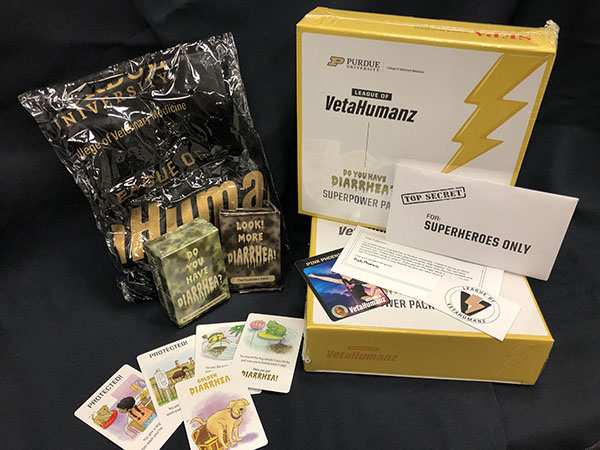Do You Have Diarrhea? SuperPower Pack
SuperPower Packs are self-guided, educational experiences for kids lacking access to in-person veterinary role models. Each SuperPower Pack contains an activity to help kids engage in veterinary careers by taking on the persona of a veterinary superhero. The Do You Have Diarrhea? SuperPower Pack, helps kids learn about causes of diarrhea in people and their animals and how to stay healthy. Thanks to support from NIH and our sponsors, we have given thousands of SuperPower Packs to under-resourced children who are participating in our programs.

2022 Academic’s Choice Award Winner
“It takes what can feel like a silly subject for kids, and creates an opportunity for children to learn about their bodies while having fun. Each child starts out with five cards and an instruction card. The game begins by one child asking another if they have a diarrhea card. As children take turns asking each other, they learn about what can cause diarrhea in both animals and humans, as well as how to avoid it. Check out this card game if you’d like your kids to have some laughs and an educational experience!”
The Unboxing
About Do You Have Diarrhea?
Do You Have Diarrhea? Is a game where kids learn about causes of diarrhea in people and their animals and how to stay healthy.
- 15 min
- 2-5
- 6+
How to Play Do You Have Diarrhea?
Download the Game
Dear Superhero,
I’m a veterinarian and teacher at Purdue University. I need to know all about diarrhea to help animals, even pigs and lizards, stay healthy. You can help animals, too! Collect pairs of diarrhea cards to learn how diarrhea spreads and use protection cards to stop it! If you put on the cape while you play, you can use my superpowers to stay healthy so you can save more animals!
Use your powers for good!
Do You Have Diarrhea? The Academic Standards
https://www.nextgenscience.org/
https://www.cdc.gov/healthyschools/health_and_academics/index.htm
Next Generation Science Standards
K-2-ETS1-1 Engineering Design
Ask questions, make observations, and gather information about a situation people want to change to define a simple problem that can be solved through the development of a new or improved object or tool.
CDC Healthy School Standards
Standard 1: Students will comprehend concepts related to health promotion and disease prevention to enhance health.
Pre-K-Grade 2
- 2.1: Identify that healthy behaviors impact personal health.
- 2.3: Describe ways to prevent communicable diseases.
Grades 3-5
- 5.1: Describe the relationship between healthy behaviors and personal health.
- 5.3: Describe ways in which safe and healthy school and community environments can promote personal health.
Standard 2: Students will analyze the influence of family, peers, culture, media, technology, and other factors on health behaviors.
Pre-K-Grade 2
- 2.1: Identify how the family influences personal health practices and behaviors.
- 2.2: Identify what the school can do to support personal health practices and behaviors.
Grades 3-5
- 5.1: Describe how family influences personal health practices and behaviors.
- 5.2: Identify the influence of culture on health practices and behaviors.
- 5.3: Identify how peers can influence healthy and unhealthy behaviors.
- 5.4: Describe how the school and community can support personal health practices and behaviors.
Standard 7: Students will demonstrate the ability to practice health-enhancing behaviors and avoid or reduce health risks.
Pre-K-Grade 2
- 2.1: Demonstrate healthy practices and behaviors to maintain or improve personal health.
- 2.2: Demonstrate behaviors that avoid or reduce health risks.
Grades 3-5
- 5.1: Identify responsible personal health behaviors.
- 5.2: Demonstrate a variety of healthy practices and behaviors to maintain or improve personal health.
- 5.3: Demonstrate a variety of behaviors to avoid or reduce health risks.
Common Core Standards- English Language Arts
Kindergarten
- ELA-LITERACY.RI.K.1: With prompting and support, ask and answer questions about key details in a text.
- ELA-LITERACY.RI.K.2: With prompting and support, identify the main topic and retell key details of a text.
- ELA-LITERACY.RI.K.3: With prompting and support, describe the connection between two individuals, events, ideas, or pieces of information in a text
- ELA-LITERACY.RI.K.4: With prompting and support, ask and answer questions about unknown words in a text.
- ELA-LITERACY.RI.K.9: With prompting and support, identify basic similarities in and differences between two texts on the same topic (e.g., in illustrations, descriptions, or procedures).
- ELA-LITERACY.RI.K.10: Actively engage in group reading activities with purpose and understanding.
1st Grade
- ELA-LITERACY.RI.1.1: Ask and answer questions about key details in a text.
- ELA-LITERACY.RI.1.2: Identify the main topic and retell key details of a text.
- ELA-LITERACY.RI.1.3: Describe the connection between two individuals, events, ideas, or pieces of information in a text.
- ELA-LITERACY.RI.1.4: Ask and answer questions to help determine or clarify the meaning of words and phrases in a text.
- ELA-LITERACY.RI.1.7: Use the illustrations and details in a text to describe its key ideas.
- ELA-LITERACY.RI.1.8: Identify the reasons an author gives to support points in a text.
- ELA-LITERACY.RI.1.10: With prompting and support, read informational texts appropriately complex for grade 1.
2nd Grade
- ELA-LITERACY.RI.2.1: Ask and answer such questions as who, what, where, when, why, and how to demonstrate understanding of key details in a text.
- ELA-LITERACY.RI.2.3: Describe the connection between a series of historical events, scientific ideas or concepts, or steps in technical procedures in a text.
- ELA-LITERACY.RI.2.4: Determine the meaning of words and phrases in a text relevant to a grade 2 topic or subject area.
- ELA-LITERACY.RI.2.6: Identify the main purpose of a text, including what the author wants to answer, explain, or describe.
- ELA-LITERACY.RI.2.7: Explain how specific images (e.g., a diagram showing how a machine works) contribute to and clarify a text.
3rd Grade
- ELA-LITERACY.RI.3.1: Ask and answer questions to demonstrate understanding of a text, referring explicitly to the text as the basis for the answers.
- ELA-LITERACY.RI.3.2: Determine the main idea of a text; recount the key details and explain how they support the main idea.
- ELA-LITERACY.RI.3.4: Determine the meaning of general academic and domain-specific words and phrases in a text relevant to a grade 3 topic or subject area.
- ELA-LITERACY.RI.3.7: Use information gained from illustrations (e.g., maps, photographs) and the words in a text to demonstrate understanding of the text (e.g., where, when, why, and how key events occur).
4th Grade
- ELA-LITERACY.RI.4.1: Refer to details and examples in a text when explaining what the text says explicitly and when drawing inferences from the text.
- ELA-LITERACY.RI.4.2: Determine the main idea of a text and explain how it is supported by key details; summarize the text.
- ELA-LITERACY.RI.4.3: Explain events, procedures, ideas, or concepts in a historical, scientific, or technical text, including what happened and why, based on specific information in the text.
- ELA-LITERACY.RI.4.7: Interpret information presented visually, orally, or quantitatively (e.g., in charts, graphs, diagrams, time lines, animations, or interactive elements on Web pages) and explain how the information contributes to an understanding of the text in which it appears.
5th Grade
- ELA-LITERACY.RI.5.2: Determine two or more main ideas of a text and explain how they are supported by key details; summarize the text.
- ELA-LITERACY.RI.5.4: Determine the meaning of general academic and domain-specific words and phrases in a text relevant to a grade 5 topic or subject area.
- ELA-LITERACY.RI.5.8: Explain how an author uses reasons and evidence to support particular points in a text, identifying which reasons and evidence support which point(s).
This program is supported by the Science Education Partnership Award (SEPA) program of the National Institute of General Medical Sciences (NIGMS) of the National Institutes of Health (NIH). Its contents are solely the responsibility of the authors and do not necessarily represent the official views of the NIH.



